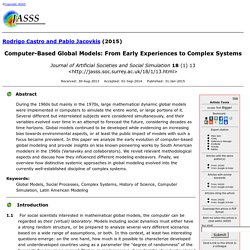

Civilization Far From Equilibrium - Energy, Complexity, and Human Survival. PLOS Pathogens: Systems Biology for Biologists. Citation: Hillmer RA (2015) Systems Biology for Biologists.

PLoS Pathog 11(5): e1004786. doi:10.1371/journal.ppat.1004786 Editor: Heather L. True-Krob, Washington University School of Medicine, UNITED STATES Published: May 14, 2015 Copyright: © 2015 Rachel A. Funding: This work has been supported by the grants IOS-1121425 and DBI-1146819 from the National Science Foundation ( and by a Doctoral Dissertation Fellowship from the University of Minnesota ( The funders had no role in study design, data collection and analysis, decision to publish, or preparation of the manuscript. Competing interests: The authors have declared that no competing interests exist.
Ce qui vient au hasard est-il complexe ? La question posée est bien sûr imprécise, et nous allons en donner plusieurs interprétations qui conduiront à plusieurs réponses.

Aucune n'est la réponse, mais leur ensemble est utile et répond à l'interrogation initiale d'une manière intéressante, nous apprenant quelque chose sur la surprise que nous ressentons quand nous découvrons que notre univers est riche et structuré. Que les théories du calcul et de l'information soient en mesure de proposer des réponses à de telles questions semblera étrange, c'est pourtant le cas. Cela nous indique que ces théories ont une portée philosophique qui n'a peut-être pas encore été bien perçue et dont il faudrait tenter l'approfondissement. La question comporte deux éléments qu'il faut préciser (« au hasard » et « complexe ») pour arriver à produire des réponses. Pour chacun des deux éléments, nous n'allons envisager que deux options que nous croyons être les principales.
Première réponse « Au hasard » aura pour sens « tiré uniformément ». How Evolutionary Dynamics Affects Network Reciprocity in Prisoner's Dilemma. APICELLA, C.

L., Marlowe, F. W., Fowler, J. Is the Hénon attractor chaotic? The Hénon map 1 is a two-parameter map of the plane defined by h( x, y) = (1 + y − ax 2, bx).

In Ref. 1 , the map h is numerically studied with parameter values ( a, b) = (1.4,0.3), and it is claimed that in this case, “depending on the initial point, the sequence of points obtained by iteration of the mapping either diverges to infinity or tends to a strange attractor.” In the following, we will refer to ( a ⋆, b ⋆) = (1.4,0.3) as the classical parameter values, and we will call the attractor existing for classical parameter values the Hénon attractor. In spite of extensive study, the long-term dynamics of the Hénon map for the classical parameter values remains unknown.
In this work, via numerical study, we attempt to answer the question whether the Hénon attractor is strange/chaotic as Hénon suggested or not. [1502.03199] What Isn't Complexity? A Survey of Agent Platforms. ACRONYMICS INC. (2004).

AGENTBUILDER: An Integrated Toolkit for Constructing Intelligent. Software Agents. Reference Manual. < Archived at < Computer-Based Global Models. AMALRIK, A. (1970).

Will the Soviet Union Survive Until 1984?. New York: Harper & Row. Beyond the Bell Curve, a New Universal Law. Imagine an archipelago where each island hosts a single tortoise species and all the islands are connected — say by rafts of flotsam.

As the tortoises interact by dipping into one another’s food supplies, their populations fluctuate. In 1972, the biologist Robert May devised a simple mathematical model that worked much like the archipelago. He wanted to figure out whether a complex ecosystem can ever be stable or whether interactions between species inevitably lead some to wipe out others. By indexing chance interactions between species as random numbers in a matrix, he calculated the critical “interaction strength” — a measure of the number of flotsam rafts, for example — needed to destabilize the ecosystem. Below this critical point, all species maintained steady populations. Little did May know, the tipping point he discovered was one of the first glimpses of a curiously pervasive statistical law. Renate Schmid Lopsided Curve Olena Shmahalo/Quanta Magazine. Velocity 2012: Richard Cook, "How Complex Systems Fail"
The dynamics of correlated novelties : Scientific Reports. Human activities data We begin by analyzing four data sets, each consisting of a sequence of elements ordered in time: (1) Texts: Here the elements are words.

A novelty in this setting is defined to occur whenever a word appears for the first time in the text; (2) Online music catalogues: The elements are songs. A novelty occurs whenever a user listens either to a song or to an artist that she has not listened to before; (3) Wikipedia: The elements are individual wikipages. A novelty corresponds to the first edit action of a given wikipage by a given contributor (the edit can be the first ever, or other contributors may have edited the page previously but that particular contributor has not); (4) Social annotation systems: In the so-called tagging sites, the elements are tags (descriptive words assigned to photographs, files, bookmarks, or other pieces of information). Full size image (281 KB) All the data sets display the predicted correlations among novelties.
SFI Bulletin V 28 - April 2014. Systems Theories. ComplexityBlog.com - Science, Engineering, and Philosophy of Complexity & Adaptive Systems. Systems Thinking World - SystemsWiki. Sociology and Complexity Science blog. The Complexity and Artificial Life Research Concept for Self-Organizing Systems. My Complexity Notebook on Springpad. L’émergence de la complexité dans l’histoire de la science. My Complexity Topic on Scoop.it. Complex Systems. Complex System Processing. Complexity. Complex Systems.